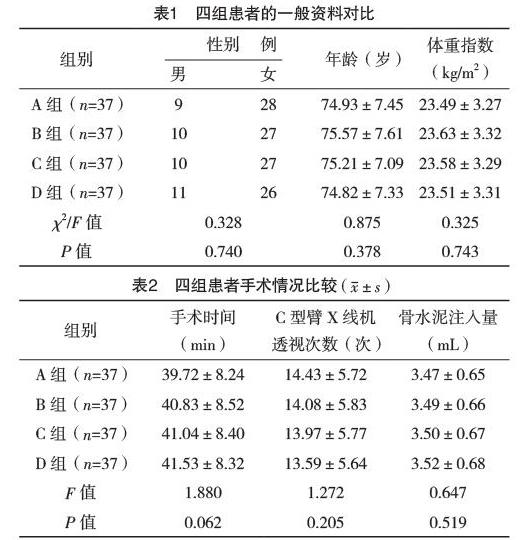PKP联合脉冲电治疗在老年OVCF中的应用效果
谭伟源 邝立鹏



【摘要】 目的:探討经皮椎体后凸成形术(percutaneous kyphoplasty,PKP)联合术后脉冲电治疗在老年骨质疏松性椎体压缩性骨折(osteoporotic vertebral compression fractures,OVCF)中的应用效果。方法:选取2014年6月-2017年12月于本院行PKP的148例老年OVCF患者为研究对象。按照随机数字表法患者分为高黏度PKP组(A组)、低黏度PKP组(B组)、高黏度PKP联合脉冲电治疗组(C组)和低黏度PKP联合脉冲电治疗组(D组),各37例。观察并对比四组患者的手术情况、治疗前后的视觉模拟评分法(visual analogue scale,VAS)评分、骨折椎体后凸Cobb角、Oswestry功能障碍指数(Oswestry disability index,ODI)及腰椎骨密度,统计四组术后骨水泥渗漏及并发症发生情况。结果:治疗后1、3、12个月,四组患者的VAS评分均较治疗前明显降低(P<0.05),C组治疗后1、3、12个月的VAS评分均低于A组(P<0.05),D组治疗后1、3、12个月的VAS评分均低于B组(P<0.05)。治疗后1、12个月,四组患者的ODI均较术前明显降低(P<0.05),C组治疗后1、12个月的ODI评分均低于A组(P<0.05),D组治疗后1、12个月的ODI均低于B组(P<0.05)。四组患者于治疗后1、12个月Cobb角均较术前明显降低(P<0.05)。A、B组患者治疗后3、12个月的腰椎骨密度与治疗前比较,差异均无统计学意义(P>0.05),而C、D组患者治疗后3、12个月的腰椎骨密度均较治疗前明显增加(P<0.05);C组治疗后3、12个月的骨密度均高于A组(P<0.05),D组治疗后3、12个月的骨密度均高于B组(P<0.05)。A组的骨水泥静脉渗漏率、椎间渗漏率、椎旁渗漏率均明显低于B组,C组的骨水泥静脉渗漏率、椎间渗漏率、椎旁渗漏率均明显低于D组(P<0.05)。结论:PKP治疗老年骨质疏松椎体压缩骨折具有良好的效果,使用高黏度骨水泥进行PKP治疗术后渗漏率更低,同时联合术后脉冲电治疗可更有效缓解疼痛,提高骨密度,改善患者腰背部功能障碍。
【关键词】 骨质疏松椎体压缩骨折; 经椎体后凸成形术; 骨水泥; 脉冲
【Abstract】 Objective:To explore the application effect of percutaneous kyphoplasty(PKP)combined postoperative pulse therapy in elderly osteoporotic vertebral compression fractures(OVCF).Method:148 elderly patients with OVCF who underwent PKP in our hospital from June 2014 to December 2017 were selected as subjects.According to the random number table method,the subjects were divided into high-viscosity PKP group(group A),low-viscosity PKP group(group B),high-viscosity PKP combined with pulse electrotherapy group(group C)and low-viscosity PKP combined with pulse electrotherapy group(group D),37 cases in each group.The operation condition,visual analogue score,Cobb angle of kyphosis,Oswestry dysfunction index and lumbar vertebral bone mineral density before and after treatment were observed and compared among the four groups,postoperative cement leakage and complications were counted among the four groups.Result:At 1,3 and 12 months after treatment,the VAS scores of the four groups were significantly lower than those before treatment(P<0.05),the VAS scores of group C at 1,3 and 12 months after treatment were lower than those of group A(P<0.05),the VAS scores of group D at 1,3 and 12 months after treatment were lower than those of group B(P<0.05).At 1 month and 12 months after treatment,the ODI scores of the four groups were significantly lower than those before treatment(P<0.05),the ODI scores of group A were lower than those of group C at 1 month and 12 months after treatment(P<0.05),while that of group D at 1 month and 12 months after treatment were lower than those of group B(P<0.05).Cobb angle of four groups were significantly lower than those before treatment at 1 month and 12 months after treatment(P<0.05);there were no significant differences in lumbar BMD between group A and group B at 3 months and 12 months after treatment(P>0.05),while there were no significant differences between group C and group D at 3 and 12 months after treatment(P<0.05).The bone mineral density of lumbar spine in group C were higher than those in group A at 3 and 12 months after treatment(P<0.05),and those in group D at 3 and 12 months after treatment were higher than those in group B(P<0.05).The leakage rate of bone cement vein,intervertebral leakage rate and paravertebral leakage rate in group A were lower than those in group B,the rates of mud vein leakage,intervertebral leakage and paravertebral leakage in group C were significantly lower than those in group D(P<0.05).Conclusion:PKP is effective in the treatment of osteoporotic vertebral compression fractures in the elderly,the leakage rate after PKP treatment with high-viscosity bone cement is lower,at the same time,combined with post-operative pulsed electric therapy can more effectively relieve pain,improve bone mineral density and improve the lumbar and back dysfunction of patients.

